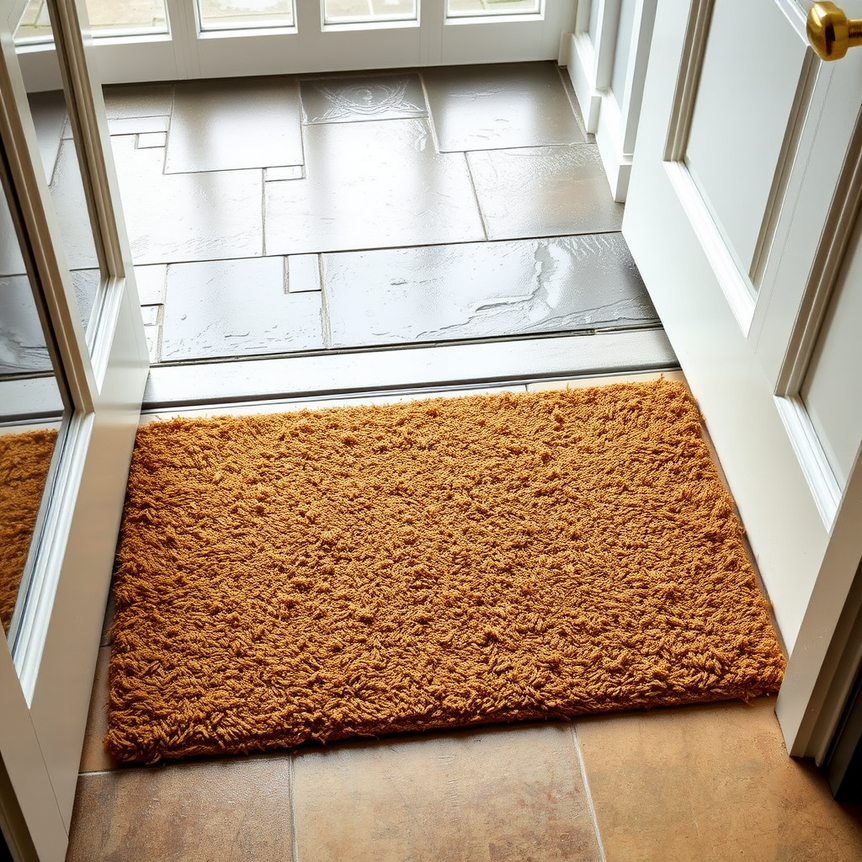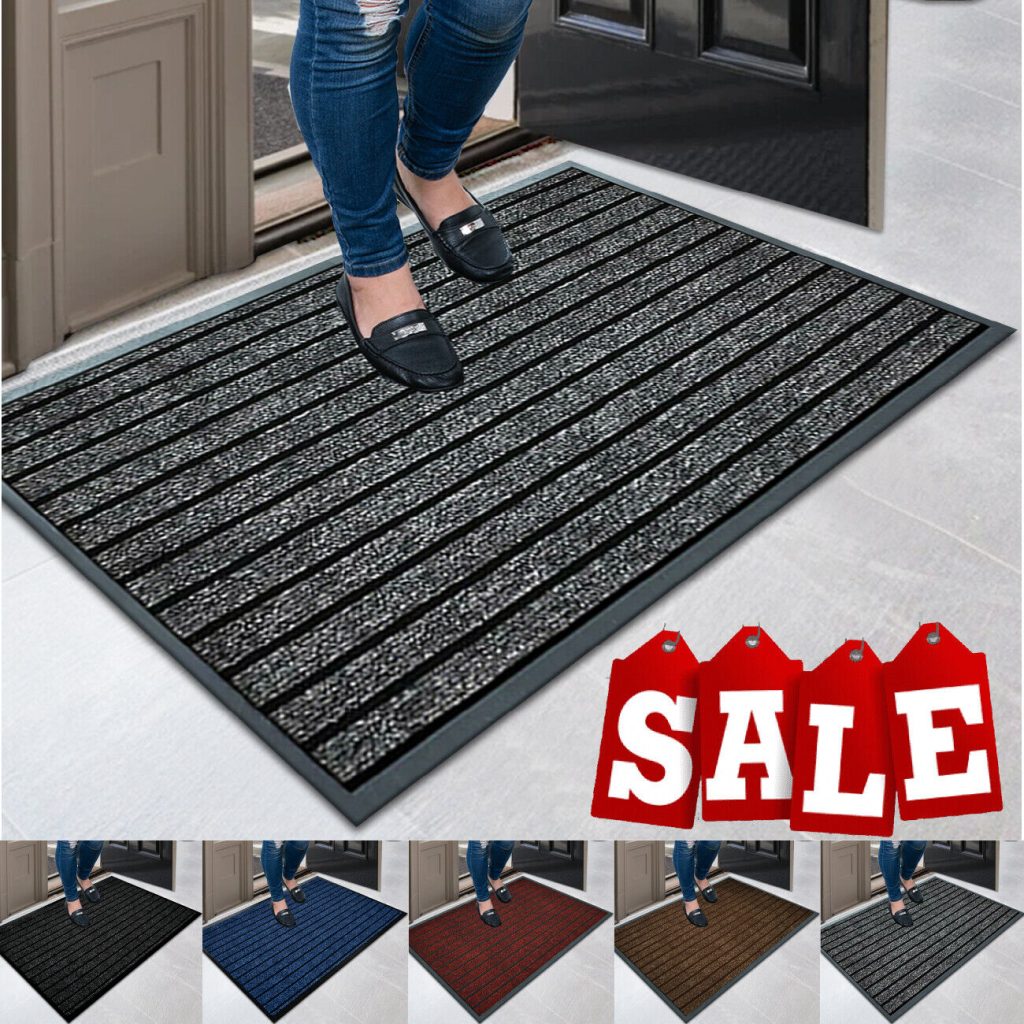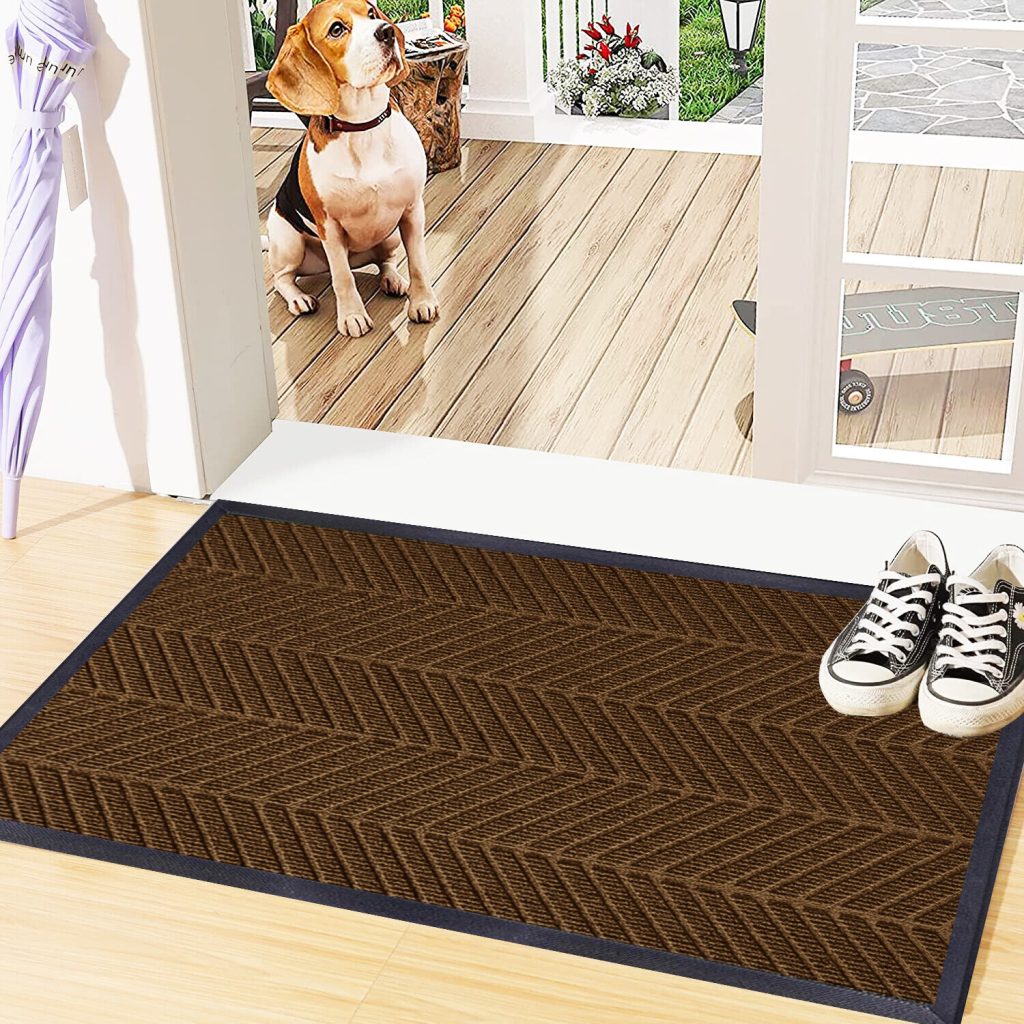A doormat that traps dirt effectively is an indispensable item for every home, particularly in the UK where wet weather and muddy conditions are frequently encountered. Choosing the right entrance mat helps to prevent dirt, mud, and moisture from being tracked into your home, thereby protecting your floors and significantly reducing the time you spend cleaning. This comprehensive guide will help UK homeowners select the ideal dirt-trapping doormat by considering crucial factors such as material, placement, size, maintenance, and eco-friendliness, all tailored for the unique British climate and lifestyle.
Why Choosing the Right Doormat Matters for UK Homes
The unpredictable UK weather frequently delivers rain, mud, and various debris onto shoes and boots. Without a quality dirt-trapping doormat, this grime can easily be tracked indoors, leading to mess and potential damage to your flooring. A well-chosen and effective door mat provides numerous benefits:
- Removes up to 80% of dirt and moisture from footwear before entry, significantly improving indoor hygiene.
- Protects flooring, carpets, and hard surfaces from premature wear and unsightly staining, extending their lifespan.
- Enhances overall indoor cleanliness, contributing to a healthier and more inviting home environment.
At Rugstars UK, we deeply understand these unique challenges faced by British households. We offer a curated selection of durable doormats specifically designed for high performance, exceptional dirt-trapping capabilities, and lasting style, perfectly suited to UK homes.
Key Materials for Dirt-Trapping Doormats: Pros and Cons
Understanding the properties of different materials is crucial for selecting a doormat that meets your specific needs for dirt control and durability. Each material offers distinct advantages and disadvantages when it comes to trapping dirt and withstanding the elements.
Overview of Common Materials for Effective Doormats
| Material | Durability | Dirt-Trapping Ability | Best Use | Eco-Friendly Aspects | Maintenance |
|---|---|---|---|---|---|
| Coir (Coconut Husk) | High — tough, highly abrasive fibres | Excellent for scraping off heavy dirt and mud | Outdoor entrances, high-traffic areas | Biodegradable, renewable resource | Shake off dirt weekly; vacuum regularly |
| Rubber | Very High — waterproof, weather-resistant | Strong scraping action with tread patterns, non-slip | Outdoor & wet climates, industrial use | Recyclable (check sourcing for recycled content) | Hose down, scrub with brush, air dry thoroughly |
| Microfiber | Moderate to High — highly absorbent | Excellent for absorbing moisture and fine dust/mud | Indoor entryways, low-pile carpets | Synthetic — less eco-friendly than natural fibres | Machine wash on gentle cycle, air dry |
| Nylon | High — resistant to wear, mould, and mildew | Captures fine dirt and moisture effectively | Indoor use, light to moderate traffic | Synthetic, often durable for long life | Vacuum regularly, spot clean or machine wash |
| Jute/Seagrass | Moderate — natural, rustic look | Moderate for dirt trapping, more decorative | Indoor decorative use, low-traffic areas | Natural, biodegradable fibres | Gentle vacuuming, avoid excessive moisture |
Maximizing Dirt Control With a Two-Mat System
For optimal dirt and moisture control, especially in British weather conditions, we highly recommend implementing a two-mat system for each entrance to your home. This layered approach creates a formidable barrier against outdoor elements:
- Outdoor Mat: Position a rugged coir mat or a durable rubber mat outside your front door. Its primary function is to aggressively scrape off heavy mud, gravel, and bulk moisture from footwear before it enters the house. When choosing an outdoor mud mat, select one that covers at least 80% of the door’s width. For standard UK doors, a mat around 90cm x 60cm (approx. 36″x24″) works very well. This initial barrier significantly reduces the amount of grime tracked indoors.
- Indoor Mat: Immediately inside the door, place a softer, highly absorbent microfiber mat or a quality nylon mat. This second mat is designed to trap any residual fine dirt, dust, and moisture that the outdoor mat might have missed, ensuring your interior floors remain pristine. This double barrier system provides unparalleled protection against indoor mess.
This strategic two-mat setup is proven to optimise dirt containment, proving particularly critical during wet autumns, muddy winters, and rainy springs typical across the UK.
Selecting the Perfect Size and Shape for Optimal Dirt Trapping
The effectiveness of a doormat that traps dirt is greatly influenced by its size and shape. A well-fitting mat ensures maximum coverage and functionality, preventing dirt from being missed around the edges.
| Shape | Best For | Reason for Effectiveness | Example Home Style |
|---|---|---|---|
| Rectangular | Most standard doorways and double doors | Covers full width, maximises foot contact for scraping, versatile | Traditional, modern, family homes |
| Half-Moon | Curved or decorative entries, smaller spaces | Adds aesthetic balance, fits snugly against rounded door frames | Cottages, period homes, stylish apartments |
| Square | Large, wide, or double doors; high-traffic areas | Offers extensive coverage, suitable for multiple people entering simultaneously | Busy households, commercial entrances, large hallways |
Always measure your door’s width and ensure the doorway mat you choose covers approximately 80% or more of that width. This ensures that most foot traffic steps onto the mat, trapping maximum dirt and avoiding missed areas on the sides.
Caring for Your Doormat to Maintain Dirt-Trapping Performance
Proper and regular upkeep is essential to extend the lifespan of your doormat and ensure it remains highly effective at trapping dirt and moisture. Different materials require specific care routines to maintain their performance and appearance:
- Coir Mats: Shake off loose dirt and debris weekly. For embedded dirt, vacuum thoroughly. Avoid prolonged soaking to prevent mould and mildew growth, which can damage the natural fibres. Consider replacing your coir mat yearly if it shows significant signs of fraying or wear in high-traffic areas.
- Rubber Mats: These are incredibly durable. Hose off thoroughly with water after heavy use or when visibly dirty. Allow them to dry completely in the air to prevent water pooling. Ensure any drainage holes remain clear to maintain their effectiveness and prevent slip hazards.
- Microfiber/Nylon Mats: Many of these absorbent indoor mats are machine washable. When dirty, machine wash on a gentle cycle with cold water. Air dry or tumble dry on low heat to preserve their texture and absorbent qualities. Avoid using fabric softeners, which can reduce absorbency.
- Natural Fibre Mats (Jute, Seagrass): Regular vacuuming is key for these mats to remove dust and dirt. Avoid heavy moisture exposure as natural fibres can be prone to rotting or developing mildew if left damp. Spot clean spills immediately with a damp cloth and mild soap.
Consistent maintenance not only preserves the aesthetic appeal of your entryway mat but critically maintains its grip, structure, and essential dirt-trapping function, ensuring your floors remain clean.
Choosing Eco-Friendly Doormats Without Sacrificing Functionality
Increasingly, UK homeowners are prioritising sustainable and environmentally friendly products for their homes. Fortunately, you don’t have to compromise on functionality when choosing an eco-conscious doormat that traps dirt. Materials like untreated coir, jute, and seagrass offer excellent performance alongside their biodegradable properties. Additionally, options like recycled rubber mats provide robust dirt-trapping capabilities while reducing waste.
When seeking an eco-friendly doormat, look for:
- Biodegradable fibres: Mats made from natural, renewable resources with minimal chemical treatments.
- Recyclable materials: Products, especially rubber mats, that are made from post-consumer recycled content or are fully recyclable at the end of their life.
- Durable designs: Investing in a long-lasting mat reduces the frequency of replacements, lessening your environmental footprint over time.
Rugstars is committed to offering a selection of doormats that meet these criteria, combining superior dirt-trapping performance with a strong sense of environmental responsibility. Many of our mats are designed for longevity and made from sustainable or recycled materials, ensuring you can keep your home clean and green.
Final Checklist: 4 Key Questions Before Buying Your Doormat
Before making your final purchase, consider these four essential questions to ensure you select the most effective doormat that traps dirt for your home:
- Is it for indoor or outdoor use? This determines the most suitable material. Outdoor mats need to withstand weather, while indoor mats focus on absorbency and fine dirt.
- What kind of weather exposure will it face? For outdoor use in the UK, prioritise waterproof materials like rubber or rugged, quick-drying coir to handle frequent rain and mud.
- How much foot traffic will it handle? High-traffic areas require reinforced, highly durable mats like heavy-duty rubber or dense coir, designed to withstand constant use without quickly wearing out.
- Does it fit the entryway size and style? Ensure the mat covers at least 80% of your doorway’s width for maximum dirt trapping. Also, consider shapes, colours, and patterns that complement your home’s existing décor and overall aesthetic.
For UK homes in need of a doormat that traps dirt reliably, focusing on durable materials like coir and robust rubber for outside, combined with absorbent microfibre or nylon for inside, is crucial. Proper placement and consistent, regular care will keep your floors significantly cleaner and your home more welcoming year-round, protecting your investment in flooring. Explore Rugstars’ expertly curated doormats, including our highly effective non-slip heavy-duty rubber mat, all designed specifically for Britain’s varying climate and diverse style needs.
Frequently Asked Questions
Q: What is the best material for a doormat that traps dirt effectively in rainy UK conditions?
A: For outdoor use in the UK’s wet climate, doormats made of coir or rubber are ideal. Coir’s coarse, bristly texture excels at scraping off mud and heavy debris, while rubber provides excellent waterproofing, durability, and essential slip resistance, making it perfect for damp conditions.
Q: Can indoor mats alone effectively trap dirt and keep my floors clean?
A: While indoor mats, especially those made of highly absorbent microfibre or nylon, are excellent for trapping fine dust and moisture, they are less effective on their own for heavy dirt. Combining them with a rugged outdoor mat creates a comprehensive two-mat barrier system that significantly enhances overall dirt and moisture containment.
Q: How often should I clean and replace my doormat to ensure maximum efficacy?
A: The frequency of cleaning depends on traffic and weather; weekly shaking or vacuuming is recommended for most. Outdoor mats, particularly coir and rubber, typically last 1-3 years depending on foot traffic and exposure. Indoor mats can last longer but should be replaced when they show significant signs of wear, tearing, loss of absorbency, or if heavily stained and unable to be cleaned effectively.Read a detailed guide here on How to Clean Rubber Mat UK.
Q: Are eco-friendly doormats as durable and functional as traditional options?
A: Yes, high-quality eco-friendly doormats, such as those made from untreated coir, jute, seagrass, or recycled rubber, can offer comparable durability and dirt-trapping functionality to traditional options. Many are designed for longevity, and while natural fibres may require more careful maintenance (like avoiding prolonged dampness), they are excellent choices for sustainable living without sacrificing performance.
Q: How do I choose a doormat that complements my home’s interior design while still being functional?
A: To balance aesthetics with functionality, consider the doormat’s material, colour, pattern, and shape. For example, natural fibre mats (coir, jute) often suit rustic or traditional homes, while sleek rubber or patterned nylon mats fit modern aesthetics. Always ensure the mat is sized correctly to cover most of your doorway (at least 80% width) for optimal dirt trapping, regardless of style.
Choosing the right doormat that traps dirt effectively involves a thoughtful combination of smart material selection, correct placement, appropriate sizing, and consistent maintenance. Use this expert advice to make an informed purchase, ensuring your UK home stays cleaner, more hygienic, and welcoming through all seasons.



